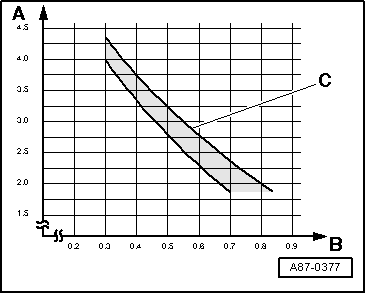| Admissible deviation from the nominal value | Possible cause of the fault | Troubleshooting |
| l
| High pressure rises only marginally above the value measured with the engine stopped. |
| l
| Low pressure decreases only marginally. |
| l
| The desired cooling power is not reached. |
| | t
| Activation of the Adjustment valve for the damaged air conditioning compressor -N280-. |
| | –
| Check activation of the Adjustment valve for the air conditioning compressor -N280-. |
|
| | | t
| The air conditioning compressor is damaged. |
| | –
| Replace the air conditioning compressor. |
|
| l
| High pressure rises above the nominal value. |
| l
| Low pressure decreases only marginally. |
| l
| The desired cooling power is not reached. |
| | t
| Bottle neck or obstruction in the refrigerant gas loop. |
| | –
| Check manually whether the refrigerant gas has temperature gradients. |
| l
| A temperature gradient was detected in one of the components: |
| –
| Replace the component if one of its rigid or flexible lines is either folded or bottle necked. |
| –
| In case of obstruction, vent the refrigerant gas loop → Chapter. |
|
| l
| High and low pressure show normal values initially. |
| l
| After some time, the high pressure rises above the nominal values. |
| l
| The low pressure decreases rapidly to the values given in the diagram or below them. |
| l
| The desired cooling power is not reached. |
| | t
| Humidity in the refrigerant gas loop. |
| | –
| Replace the collection tank. |
| –
| Recheck in case of malfunction. |
|
| l
| High pressure is normal. |
| l
| Low pressure is very low (see diagram). |
| l
| The desired cooling power is not reached. |
| | t
| Activation of the Adjustment valve for the damaged air conditioning compressor -N280-. |
| | –
| Check activation of the Adjustment valve for the air conditioning compressor -N280-. |
|
| | | t
| The air conditioning compressor is damaged. |
| | –
| Replace the air conditioning compressor. |
|
 Note
Note
 Note
Note Note
Note Note
Note